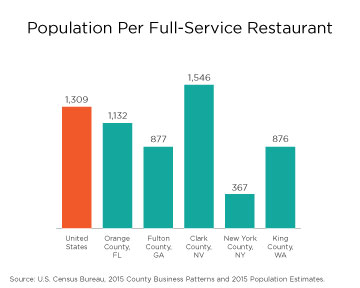Measuring the Impact of Tourism to Local Areas
Measuring the Impact of Tourism to Local Areas
Earlier this year, the U.S. Census Bureau highlighted business data with a graphic that matched the number of car rental establishments in select U.S. cities with recent population estimates. The graphic showed the 15 cities with the most rental car establishments, as well as those with the highest concentration per 100,000 residents. New York City, for example, has the third-highest count of rental car establishments on this list but the lowest number of rental car establishments relative to its population. In comparison, Orlando has 15 times as many places to rent a car per person as New York City.
Does tourism explain the difference? In short, maybe…
While it is true that many tourists rent cars while they are on vacation, people rent cars for other reasons too. In addition, there may be other factors (including how accessible public transportation is or how “walkable” these tourist hotspots may have become) that affect this ratio of the resident population and the number of rental car businesses in an area.
So, how closely correlated is the population in an area to the number of businesses in other tourism industries? The graph below shows the ratio of population to the number of hotels and motels for selected counties.
It also shows the number of people each hotel “serves” in tourist destinations like Orange County, Fla. (Orlando); New York County, N.Y. (New York City); and Fulton County, Ga. (Atlanta), is lower than the national average. This might indicate that these hotels serve guests other than just county residents. But what about Clark County, Nev. (Las Vegas)? The relatively high ratio of population per hotel here is because casino hotels are excluded from the industry shown.
What about other tourism-associated industries?
The graphs below look at this same relationship between resident population and businesses by county for full-service restaurants and travel agencies. Similar to data regarding hotels, there is a relatively low number of customers per restaurant for these tourist cities, but there are also “foodie” areas like King County, Wash. (Seattle) with similar ratios. Travel agencies also show a similar pattern of low resident population in comparison to the number of travel agencies.
So what can we make of this?
While it is clear that tourism plays a significant role in the success of certain types of businesses across various areas of the country, entrepreneurs who are interested in opening these businesses need to look at all potential customers of their business. The Census Bureau provides a wealth of demographic, socio-economic and business data (and data tools, like Census Business Builder) that can be useful in helping entrepreneurs identify underserved areas for new business opportunities. These data can help entrepreneurs make evidence-based decisions that result in business success.
Additional graphics included as part of the travel series are: Revenue in the Travel Accommodation Industry, Revenue From Marinas, and Government Revenue From Airports.
-X-






